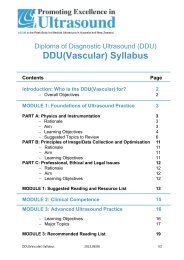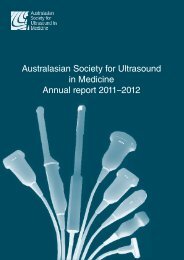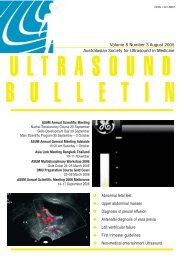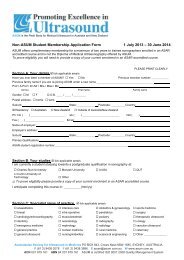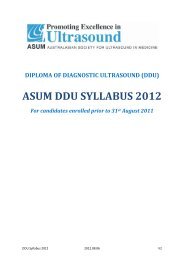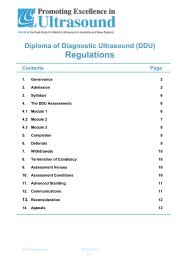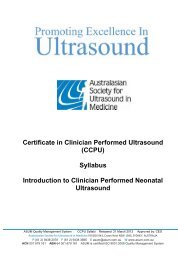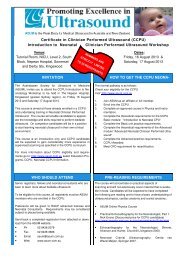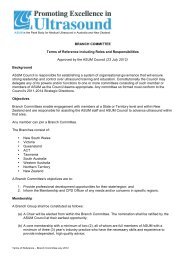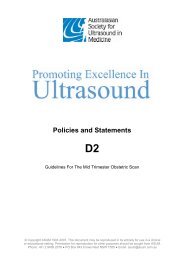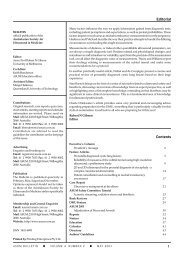Volume 6 Issue 3 - Australasian Society for Ultrasound in Medicine
Volume 6 Issue 3 - Australasian Society for Ultrasound in Medicine
Volume 6 Issue 3 - Australasian Society for Ultrasound in Medicine
- No tags were found...
You also want an ePaper? Increase the reach of your titles
YUMPU automatically turns print PDFs into web optimized ePapers that Google loves.
Key issues <strong>in</strong> the analysis of safety of diagnostic ultrasound<br />
“A diagnostic exposure that elevates embryonic and fetal <strong>in</strong> situ<br />
temperature above 41ºC (4ºC above normal temperature) <strong>for</strong> 5 m<strong>in</strong><br />
or more should be considered potentially hazardous.”<br />
There is some evidence to suggest that ultrasound-<strong>in</strong>duced<br />
bioeffects can be enhanced by modest <strong>in</strong>creases <strong>in</strong><br />
temperature. Studies on embryonic development us<strong>in</strong>g a<br />
novel test-tube culture process that allowed <strong>in</strong>teraction with<br />
carefully characterised ultrasound fields and temperature 8,9 .<br />
Rat embryos were grown and <strong>in</strong>sonated <strong>in</strong> test tubes to avoid<br />
the effects of maternal physiology. The results of this study<br />
clearly demonstrated severe abnormalities <strong>in</strong> bra<strong>in</strong><br />
development at high ultrasound exposures. However, at<br />
levels equivalent to diagnostic pulsed Doppler applications<br />
there was no measurable adverse effect as long as<br />
temperature did not <strong>in</strong>crease. A mild elevation of 1.5°C above<br />
normal together with ultrasound exposure <strong>for</strong> 15 m<strong>in</strong>utes.<br />
caused retarded bra<strong>in</strong> growth and <strong>in</strong>creased synthesis of<br />
heat shock (stress) prote<strong>in</strong>s. There may be an <strong>in</strong>creased risk<br />
to febrile patients from hyperthermic damage, s<strong>in</strong>ce their<br />
elevated core temperature would add to the ultrasound<strong>in</strong>duced<br />
heat<strong>in</strong>g of the embryo or fetus. In all ultrasound<br />
applications thermally <strong>in</strong>duced adverse effects can be<br />
avoided by m<strong>in</strong>imis<strong>in</strong>g TI and duration of exposure.<br />
NON-THERMAL STRESSES<br />
Acoustic <strong>in</strong>ertial cavitation is a non-thermal phenomenon<br />
that <strong>in</strong>volves collapse of bubbles <strong>in</strong> liquid <strong>in</strong> a sound field<br />
and the sudden release of energy that can be sufficiently<br />
<strong>in</strong>tense to disrupt molecular bonds. The released chemicallyreactive<br />
free-radicals have the potential to <strong>in</strong>terfere with<br />
DNA and cause chromosomal damage. Although this effect<br />
has been reported <strong>in</strong> contrived laboratory studies at high<br />
<strong>in</strong>tensities, it has not been directly observed <strong>in</strong> patients or<br />
<strong>in</strong> animals exposed to diagnostic <strong>in</strong>tensities.<br />
Dur<strong>in</strong>g the past decade a number of studies reported<br />
ultrasound-<strong>in</strong>duced haemorrhagic lesions <strong>in</strong> tissues of lungs<br />
and <strong>in</strong>test<strong>in</strong>es <strong>in</strong> mammals follow<strong>in</strong>g brief exposure to the<br />
maximum operat<strong>in</strong>g conditions <strong>in</strong> diagnostic equipment.<br />
The effect depends on the presence of a tissue/air <strong>in</strong>terface,<br />
suggest<strong>in</strong>g that it is unlikely to have cl<strong>in</strong>ical significance to<br />
obstetrical ultrasound exam<strong>in</strong>ations. Capillary bleed<strong>in</strong>g has<br />
been repeatedly demonstrated <strong>in</strong> lungs of various animal<br />
species follow<strong>in</strong>g exposure to diagnostic ultrasound. The<br />
essential condition <strong>for</strong> this cavitation-related <strong>in</strong>teraction is<br />
the presence of tissue/gas boundary <strong>in</strong>terfaces, as occurs at<br />
the alveoli surface of the lung. As the onset of cavitation can<br />
occur with<strong>in</strong> a diagnostic pulse, these bioeffects have been<br />
observed after exposures as brief as 20 seconds 10 . There is no<br />
evidence of tissue damage <strong>in</strong> the fetus where the lungs are<br />
not normally <strong>in</strong>flated. In cl<strong>in</strong>ical applications, there is a risk<br />
of lung hemorrhage <strong>in</strong> the premature neonate dur<strong>in</strong>g pulsed<br />
Doppler echo-cardiographic exam<strong>in</strong>ations. The cl<strong>in</strong>ical<br />
implications are uncerta<strong>in</strong>, but assumed to be trivial<br />
compared with the potential benefit from improved<br />
diagnosis that might be obta<strong>in</strong>ed <strong>for</strong> such physiologically<br />
compromised neonates.<br />
Radiation pressure causes acoustic stream<strong>in</strong>g of fluid along<br />
the path of an ultrasound beam. There is evidence that<br />
acoustic stream<strong>in</strong>g occurs <strong>in</strong> liquid-filled body cavities<br />
dur<strong>in</strong>g exposure to diagnostic ultrasound, particularly when<br />
used <strong>in</strong> pulsed Doppler mode 6,11 . However, the effects of its<br />
associated shear <strong>for</strong>ces are uncerta<strong>in</strong>. Embryonic tissue does<br />
not have the structural strength of the <strong>in</strong>tercellular matrix<br />
that develops <strong>in</strong> later fetal and post-natal life. Thus, the<br />
period of embryonic development, particularly dur<strong>in</strong>g cell<br />
differentiation and neuronal cell migration, may be<br />
vulnerable to mechanical stress. There is <strong>in</strong>sufficient<br />
evidence to determ<strong>in</strong>e whether or not the passage of an<br />
ultrasound beam could exert sufficient radiation stress to<br />
cause permanent displacement of sensitive proliferat<strong>in</strong>g<br />
cells, <strong>for</strong> example, <strong>in</strong> the develop<strong>in</strong>g human central nervous<br />
system. However, there is some evidence from animal studies<br />
that embryonic development can be delayed or disturbed<br />
when such shear <strong>for</strong>ces occur <strong>in</strong> the presence of a modest<br />
<strong>in</strong>crease <strong>in</strong> temperature 8,9 . The 1.5°C temperature rise<br />
needed <strong>for</strong> these reported effects is with<strong>in</strong> the capability of<br />
some modern equipment output. The implication of these<br />
f<strong>in</strong>d<strong>in</strong>gs to embryo-sonology is uncerta<strong>in</strong>, however it does<br />
suggest that a cautionary approach is justified. The<br />
associated stresses may <strong>in</strong>teract and/or disrupt fragile<br />
embryonic tissue elements.<br />
CONTRAST AGENTS ENHANCE BIOEFFECTS<br />
The <strong>in</strong>troduction of gas-stabilised echo-contrast agents <strong>in</strong>to<br />
the sound field greatly <strong>in</strong>creases the likelihood of produc<strong>in</strong>g<br />
cavitation bioeffects 7 and these have been observed <strong>in</strong> cells,<br />
animals and <strong>in</strong> humans. A recent study has reported<br />
premature ventricular contractions (PVC) <strong>in</strong> healthy human<br />
subjects dur<strong>in</strong>g triggered harmonic imag<strong>in</strong>g of the heart<br />
follow<strong>in</strong>g <strong>in</strong>jection of an ultrasound contrast agent 12 . A<br />
commercially available ultrasound imag<strong>in</strong>g device produced<br />
a substantial effect (<strong>in</strong>crease <strong>in</strong> PVC rate by two orders of<br />
magnitude) at MI=1.5, i.e. with<strong>in</strong> the limits of FDA approved<br />
diagnostic exposure. The issue of arrhythmias <strong>in</strong> humans<br />
and perivascular <strong>in</strong>jury <strong>in</strong> animals exposed to pulsed<br />
ultrasound after adm<strong>in</strong>istration of contrast agents is<br />
succ<strong>in</strong>ctly described <strong>in</strong> recent review article 13 .<br />
The subject of enhanced effects that might be produced<br />
when gas encapsulated echo-contrast agents are <strong>in</strong>troduced<br />
<strong>in</strong>to the sound field is yet to be fully evaluated. The use of<br />
gas-encapsulated echo-contrast materials to enhance<br />
sonographic imag<strong>in</strong>g <strong>in</strong>creases the probability of cavitation.<br />
Cavitation-related biological effects can be avoided by<br />
reduc<strong>in</strong>g the peak amplitude, or by us<strong>in</strong>g a low value MI<br />
(mechanical <strong>in</strong>dex) on equipment with an output display.<br />
The presence of contrast agents should be taken <strong>in</strong>to account<br />
when consider<strong>in</strong>g the risk/benefit ratio of an ultrasound<br />
exam<strong>in</strong>ation.<br />
HUMAN STUDIES<br />
Whilst there is no conv<strong>in</strong>c<strong>in</strong>g evidence of a causal<br />
relationship between ultrasound exposure and adverse<br />
health outcome, the scientific literature conta<strong>in</strong>s occasional<br />
reports of effects that are difficult to expla<strong>in</strong>. Perturbation of<br />
neuron migration <strong>in</strong> 2 nd trimester can produce subtle neurophysiological<br />
effects and has been suggested as a possible<br />
mechanism <strong>for</strong> reports of <strong>in</strong>creased <strong>in</strong>cidence of non-righthandedness<br />
14,15 <strong>in</strong> boys that were exposed prenatally to<br />
diagnostic ultrasound. It is difficult to attribute a responsible<br />
ultrasound mechanism from brief cl<strong>in</strong>ical exposure to B-<br />
mode scann<strong>in</strong>g at the low <strong>in</strong>tensity levels that were used<br />
42 ASUM ULTRASOUND BULLETIN VOLUME 6 NUMBER 3 AUGUST 2003




